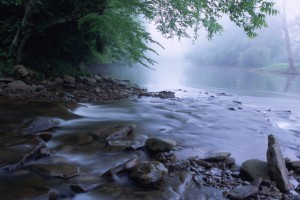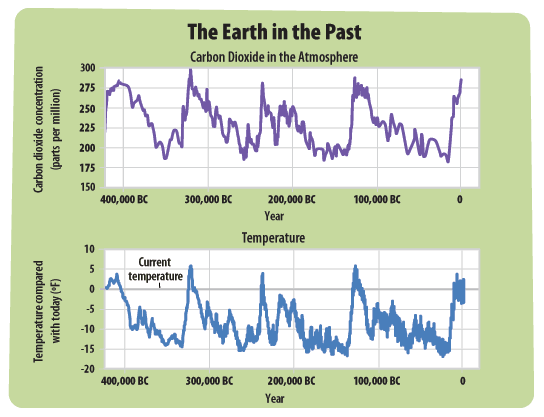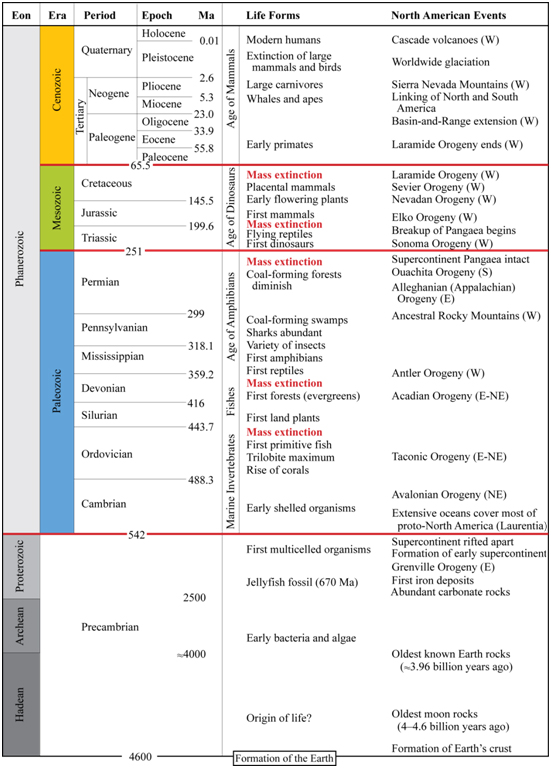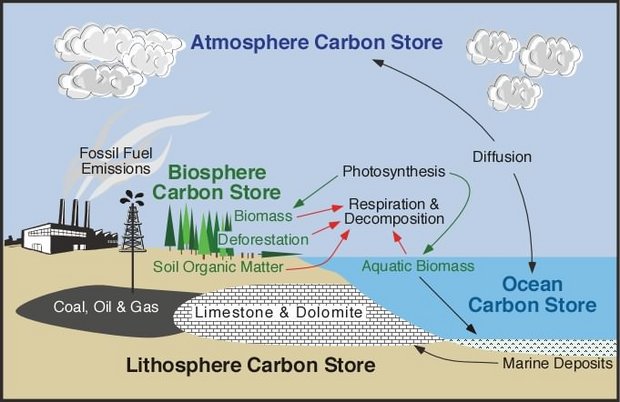Climate Literacy: The Essential Principles of Climate Sciences summarizes the most important principles and concepts of climate science. It presents information that individuals and communities need to understand Earth’s climate, impacts of climate change, and approaches for adapting and mitigating change. This article provides science content knowledge for understanding Essential Principle 3.
Life on Earth depends on, is shaped by, and affects climate is the third of seven Essential Principles of Climate Sciences. The essence of this principle is that life affects climate and, in turn, the climate dictates where and how species can survive. All organisms affect the composition of the atmosphere because they take in and release gases, such as carbon dioxide and methane, which maintain the “natural” greenhouse effect that makes life on Earth possible. This is different from the “human-caused” greenhouse effect that results from burning fossil fuels. The recent increases in greenhouse gas concentrations are unprecedented in the geologic past.
The climate around the globe gives rise to a variety of ecosystems. Changes to climate affect organisms found in those ecosystems; organisms respond to climate changes by adapting or migrating. Species can also die out because they have only limited ability to adapt to environmental changes. Humans have a responsibility to stabilize the natural climatic conditions in order to preserve the environments in which humans and the surrounding ecosystems thrive.
Before we continue, let’s define climate. Many times the terms “climate” and “weather” are used interchangeably – but they are not the same thing. Weather is a specific event or condition that happens over a period of hours or days. For example, a thunderstorm, a snowstorm, and today’s temperature all describe the weather. Climate is the long-term weather pattern of an area, including temperature, precipitation, and wind. For example, the climate in Fargo, North Dakota, is cold and snowy in the winter, while the climate in Key West, Florida, is hot and humid.
Meteorologists often point out that “climate is what you expect and weather is what you get.” As defined by the World Meteorological Organization (WMO), the classical length of record to determine the climate for any particular place is 30 years. The factors most often observed are temperature, precipitation, and wind as well as cloud cover and depth of frost penetration. So when we say “climate” we are talking changes in long-term weather patterns.
The following concepts are fundamental to understanding Principle 3. You can click on a concept to find the background knowledge to help you understand the concept.
Note: For additional ideas and resources for teaching each of the Essential Principles of Climate Sciences go to the Climate Literacy & Energy Awareness Network. Another good introduction to the seven essential principles is Earth: The Operator’s Manual, an hour-long film shown on PBS and based on the book of the same name by Richard Alley. The entire film is available but the site also provides short segments for teachers to preview and download (free, simple registration required), both with closed captioning for ESL and science comprehension support. A video from the U.S. Environmental Protection Agency (EPA), Climate 101 (second row, middle) explores what climate change is, signs or indicators that the planet is warming, and why it matters. Watch the video to learn more about the causes and effects of climate change and practical solutions to reduce carbon dioxide and other greenhouse gas emissions. An excellent rebuttal of climate change skeptics can be found in Why the Global Warming Skeptics Are Wrong (published 2/22/2012).
Concept A. Individual organisms survive within specific ranges of temperature, precipitation, humidity, and sunlight. Organisms exposed to climate conditions outside their normal range must adapt or migrate, or they will perish.
Concept B. The presence of small amounts of heat-trapping greenhouse gases in the atmosphere warms Earth’s surface, resulting in a planet that sustains liquid water and life.
Concept C. Changes in climate conditions can affect the health and function of ecosystems and the survival of entire species. The distribution patterns of fossils show evidence of gradual as well as abrupt extinctions related to climate change in the past.
Concept D. A range of natural records shows that the last 10,000 years have been an unusually stable period in Earth’s climate history. Modern human societies developed during this time. The agricultural, economic, and transportation systems we rely upon are vulnerable if the climate changes significantly.
Concept E. Life – including microbes, plants, and animals and humans – is a major driver of the global carbon cycle and can influence global climate by modifying the chemical makeup of the atmosphere. The geologic record shows that life has significantly altered the atmosphere during Earth’s history.
You can also see where these concepts are found in national standards documents as well as common misconceptions in the Standards and Curriculum Connections article.
Concept A. Individual organisms survive within specific ranges of temperature, precipitation, humidity, and sunlight. Organisms exposed to climate conditions outside their normal range must adapt or migrate, or they will perish.
Most plants and animals live in areas with very specific climate conditions, such as temperature and rainfall patterns. Any change in the climate of an area can affect the plants and animals living there, as well as the makeup of the entire ecosystem. Plants and animals have adapted to changes in the environment for millions of years. However, today’s changes are happening faster and on a larger scale than in the past, which makes it difficult for plants and animals to adapt. Some species are already responding to a warmer climate by moving to cooler locations. For example, some North American animals and plants are moving farther north or to higher elevations to find suitable places to live.
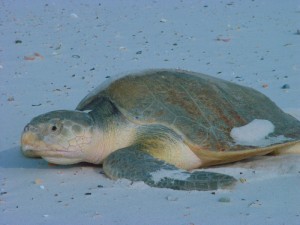
Beautiful Kemp's Ridley sea turtle (Endangered species). Image courtesy of the U.S. Fish & Wildlife Service.
Climate change also alters the life cycles of plants and animals. For example, as temperatures get warmer, many plants are starting to grow and bloom earlier in the spring and survive longer into the fall. Some animals are waking from hibernation sooner or migrating at different times, too. Some unwelcome invaders (invasive species) could benefit from climate change by expanding their range or being able to survive through the winter in new places.
So what does it mean “to adapt”? This means that organisms have characteristics that allow them to live successfully in their habitat. Adaptation has a genetic basis. The need or desire to change in some way in order to survive has no impact on the information that is already present in an individual’s genes. This reflects anthropomorphic reasoning – the idea that organisms can consciously decide to change and that change comes about because of need or desire.
Variations occur among the individuals of any population of organisms. Some variations affect survival, some don’t. A trait that increases an organism’s survival may lead to an increased reproduction rate. However, the environment acts as a filter through which only certain variations can pass. This process, called natural selection, may result in adaptations that allow populations to adapt to environments or even the development of entirely new species.
Related Resources
Life Science Session 5. Variation, Adaptation, and Natural Selection
This link goes to Session 5 of the Essential Science for Teachers: Life Science online course designed to help K-6 teachers enhance their understandings of “big ideas” in the life sciences. Each session includes a short video with background information and activities and lessons that support the content covered in the session.
Climate Change Wildlife & Wildlands Toolkit and Video
This resource divides the United States into 11 distinct “ecoregions” based on a number of factors, including geography and habit type. Each ecoregion includes a case study and activities that will bring alive the impacts and solutions to climate change. A 12-minute video on climate change science and impacts on wildlife and their habitat is also available.
Ocean Adventures
The themes of adaptations, ecosystems and human impact are interwoven throughout the Ocean Adventures episodes and educational materials. Designed primarily for middle school educators and students, these lessons accompany the video series.
Citizen Science Projects
Track when leaves grow and flowers bloom in the spring:
Observe migrating patterns:
- National Audubon Society
- Cornell Lab of Ornithology
- Monarch Butterfly Studies
- National Phenology Network
Monitor invasive species:
Concept B. The presence of small amounts of heat-trapping greenhouse gases in the atmosphere warms Earth’s surface, resulting in a planet that sustains liquid water and life.
There are two meanings of the term “greenhouse effect.” There is a “natural” greenhouse effect that keeps the Earth’s climate warm and habitable and makes life on Earth possible. There is also the human-generated greenhouse effect, which is the enhancement of Earth’s natural greenhouse effect by the addition of greenhouse gases from the burning of fossil fuels (mainly petroleum, coal, and natural gas).
Without the natural greenhouse gases in the atmosphere, the average temperature of Earth would be 30 degrees Celsius lower (86 degrees Fahrenheit lower). Comparing Earth to our closest planetary neighbors provides excellent examples. Venus provides an example of what happens when concentrations of greenhouse gases are very high. Venus’s atmosphere is more than 96 percent carbon dioxide (compared to 0.038 percent on Earth), and the temperature can reach 460 degrees Celsius (890 degrees Fahrenheit). On the other hand, the planet Mars has a very thin atmosphere and is quite cold at minus 63 degrees Celsius (minus 81 degrees Fahrenheit).
So how does the greenhouse effect work? Once the Sun’s energy reaches Earth, it is intercepted first by the atmosphere. A small part of the Sun’s energy is directly absorbed, particularly by certain gases such as water vapor. Some of the Sun’s energy is reflected back to space by clouds and the Earth’s surface.
Most of the radiation, however, is absorbed by Earth’s surface. When the radiation is absorbed by a substance, the atoms in the substance move faster and the substance becomes warm to the touch. The absorbed energy is transformed into heat energy. This heat energy plays an important role in regulating the temperature of Earth’s crust, surface waters, and lower atmosphere.
Related Resources
Climate Kids: What Is the Greenhouse Effect?
In question-and-answer format with many illustrations, this site answers questions a student might have about the greenhouse effect. The site also includes questions scientists are trying to find answers to, all written in an easy-to-read style.
Greenhouse Effect Movie
In this movie, Professor Scott Denning of the Atmospheric Science Department at Colorado State University explains how greenhouse gases in Earth’s atmosphere warm our planet. Denning first explains how visible light (a form of electromagnetic radiation) from the Sun delivers energy to Earth. Next, he describes how some of this energy is trapped in Earth’s atmosphere by the greenhouse effect, which warms our planet. Molecules of greenhouse gases, especially water vapor and carbon dioxide, “recycle” some of the heat energy that would otherwise escape from Earth in the form of infrared radiation.
Concept C. Changes in climate conditions can affect the health and function of ecosystems and the survival of entire species. The distribution patterns of fossils show evidence of gradual as well as abrupt extinctions related to climate change in the past.
Paleoclimatologists look for clues in rocks, sediments, ice sheets, tree rings, corals, shells, and fossils to determine the past states of the Earth’s various climate regions and its atmosphere and how they have changed over millions of years.
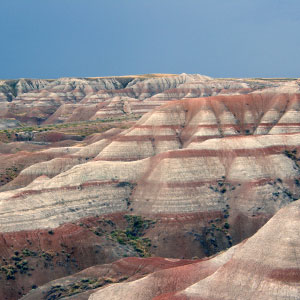
Ancient soil layers – paleosols – form the dramatic stripes in Badlands National Park (South Dakota). Photo courtesy of the National Park Service.
The graphs below provide a picture of Earth’s past temperature and carbon dioxide levels based on Vostok ice core samples from Antarctica. They do not include the most recent increases in carbon dioxide and temperature caused by humans. Notice the strong connection between carbon dioxide and temperature.
Using fossils and many geologic clues, geologists have reconstructed Earth’s climate going back hundreds of millions of years. These clues have pointed to mass extinctions over many millennia – most of which have been attributed to climate change.
Science writer David Biello (2007) explains, “Roughly 251 million years ago, an estimated 70 percent of land plants and animals died, along with 84 percent of ocean organisms – an event known as the end Permian extinction. The cause is unknown but it is known that this period was also an extremely warm one. A new analysis of the temperature and fossil records over the past 520 million years reveals that the end of the Permian is not alone in this association: global warming is consistently associated with planetwide die-offs.”
About 450 million years ago, Earth suffered the second-largest mass extinction in its history – the Late Ordovician mass extinction, during which more than 75 percent of marine species died. Exactly what caused this tremendous loss in biodiversity remains a mystery, but now a team led by researchers at the California Institute of Technology (2011) has discovered new details supporting the idea that the mass extinction was linked to a cooling climate.
References
Biello, D. 2007. “Mass Extinctions Tied to Past Climate Changes.” Scientific American. October 24. Retrieved from http://www.scientificamerican.com/article.cfm?id=mass-extinctions-tied-to-past-climate-changes
California Institute of Technology. (2011), “Mass Extinction Linked to Ancient Climate Change, New Details Reveal.” ScienceDaily.May 31. Retrieved from http://www.sciencedaily.com/releases/2011/01/110127141703.htm
Related Resource
Climate Change in the Fossil Record
This site, by the National Park Service, tells the story of the history of the Earth by looking at the fossil record. Images are provided that compare national parks now and what they looked like in the Earth’s distant past.
Concept D. A range of natural records shows that the last 10,000 years have been an unusually stable period in Earth’s climate history. Modern human societies developed during this time. The agricultural, economic, and transportation systems we rely upon are vulnerable if the climate changes significantly.
Human civilizations arose during the Holocene Period – the past 10,000 years since the last ice age, a period when human population rose from around 5 million to over 6 billion people. The following table from the U.S. Department of Commerce National Climatic Data Center provides an overview of the human developments that occurred as the human population rose.
Holocene Timeline
| Years Before Present (B.P.) and Human Population (estimates from UNESCO) |
Human Developments |
| 1,000 (254-345 million) |
-Storage of rye results in occasional growth of a toxic fungal infection (ergot) known as St. Anthony’s fire that can cause hallucinations. -Chinese develop gunpowder. |
| 2,000 (170-300 million) |
-Spice trade becomes important. European sailors discover how to use monsoon patterns to their advantage. |
| 3,000 (50 million) |
-Peanuts grown in Peru. Iron age in Europe and Middle East. -Phoenicians sail in the Mediterranean while Polynesians sail the Pacific. -Iron Age begins around 2,650 years ago. |
| 4,000 (27 million) |
-Bronze smelted in Middle East, combining copper and tin, beginning the Bronze Age. -Olives, peaches and apricots cultivated in Eastern Mediterranean. -Drought around 2000 B.C. may have contributed to the collapse of the Akkadia civilization in Mesopotamia, which is regarded as the world’s first empire. -Evidence of drought also found along Nile in Egypt, Indus in India and in the Great Basin of western North America. |
| 5,000 (14 million) |
-Five sacred crops in ancient China: soybeans, rice, wheat, barley and millet. -Sorghum used in sub-Saharan Africa. -Egypt unified under one Pharaoh. |
| 6,000 (7 million) |
-Neolithic (New Stone Age) period, with farming and elaborate stone houses built in Britain. -Cotton grown in Pakistan, cultivated grapes in Afghanistan. |
| 7,000 (5 million) |
-Squashes, beans, chili peppers and an early type of corn (Zea mays) cultivated in Meso-America. -Domesticated rice used in China. |
| 8,000 (5 million) |
-Lentils, fava beans and chick peas become part of eastern Mediterranean, with chili pepper and lima beans being used in Peruvian highlands. -Rising sea levels of Mediterranean Sea flood into the basin that now forms the Black Sea around 7,600 years ago. -Copper first smelted around this time period. |
| 9,000 (5 million) |
-During Mesolithic period, semi-permanent houses are used and boats are built for transport and fishing. -Flax in Syria and Turkey for clothing (linen) and oil. -Abrupt climate change causes much of the planet to become cooler and drier around 8,200 years ago. |
| 10,000 (5 million) |
-First evidence of plant domestication. -Wheat and barley developed in Near East. Barley becomes a daily food staple. -An estimated 5 million people inhabit the entire planet |
There is general consensus that the agricultural, economic, and transportation systems we rely upon are vulnerable if the climate changes significantly. Agriculture could be affected a variety of ways:
- productivity in terms of quantity and quality of crops;
- agricultural practices through changes of water use (irrigation) and agricultural inputs such as herbicides, insecticides and fertilizers;
- environmental effects in particular in relation of frequency and intensity of soil drainage (leading to nitrogen leaching), soil erosion, and reduction of crop diversity; and
- adaptation by which organisms may become more or less competitive.
Concept E. Life – including microbes, plants, and animals and humans – is a major driver of the global carbon cycle and can influence global climate by modifying the chemical makeup of the atmosphere. The geologic record shows that life has significantly altered the atmosphere during Earth’s history.
Carbon (C), the fourth most abundant element in the Universe, after hydrogen (H), helium (He), and oxygen (O), is the building block of life. It’s the element that anchors all organic substances, from fossil fuels to DNA. On Earth, carbon cycles through the land, ocean, atmosphere, and the Earth’s interior in a major biogeochemical cycle (the circulation of chemical components through the biosphere from or to the lithosphere, atmosphere, and hydrosphere).
Carbon cycling involves many carbon-containing compounds and biological processes such as photosynthesis. On a longer time span, carbon dioxide is moved from the atmosphere and the ocean and into the ground through biologic and geologic processes. Some carbon is transformed into calcium carbonate (limestone), the largest carbon reservoir on Earth as shown in the following image. Carbon is reduced by the accumulation of seafloor sediments and the uptake of carbon by plants as they make carbohydrates.
Biology also plays an important role in the movement of carbon in and out of the land and ocean through the processes of photosynthesis and respiration. Nearly all forms of life on Earth depend on the production of sugars from solar energy and carbon dioxide (photosynthesis) and the metabolism (respiration) of those sugars to produce the chemical energy that facilitates growth and reproduction.
Two processes that increase the abundance of carbon in the atmosphere are deforestation and the combustion of fossil fuels – basically the reverse of the two processes that decrease the amount of carbon in the atmosphere. Trees are natural consumers of carbon dioxide – one of the greenhouse gases whose buildup in the atmosphere contributes to global warming. Destruction of trees not only removes these “carbon sinks,” but tree burning and decomposition pump into the atmosphere even more carbon dioxide, along with methane, another major greenhouse gas. Burning any fossil fuel produces carbon dioxide, which contributes to the greenhouse effect warming Earth.
Related Resources
Global Warming: It’s All About Carbon
A five-part series of humorous animated shorts that illustrate the central role that carbon plays in climate change. From NPR’s Climate Connections series.
Photosynthesis
This video segment from Interactive NOVA: Earth explores the history of plant biology. It takes the viewer from the earliest scientific hypotheses that plants ate dirt to our present-day understanding of photosynthesis, the process by which plants use the sun’s energy to convert carbon dioxide and water into carbohydrates, a storable form of chemical energy.
Carbon Dioxide and the Greenhouse Effect
Human activities are causing increasing amounts of carbon dioxide to be pumped into the atmosphere. This video segment adapted from NOVA/FRONTLINE demonstrates carbon dioxide’s role in the greenhouse effect and explains how increasing concentrations of this gas in the atmosphere may be contributing to global warming.
Kimberly Lightle wrote this article. She received her PhD in science education at The Ohio State University and is principal investigator of Beyond Weather and the Water Cycle, Beyond Penguins and Polar Bears, and the Middle School Portal 2 projects. Email Kim at beyondweather@msteacher.org
Copyright May 2011 – The Ohio State University. This material is based upon work supported by the National Science Foundation under Grant No. 1034922. Any opinions, findings, and conclusions or recommendations expressed in this material are those of the author(s) and do not necessarily reflect the views of the National Science Foundation. This work is licensed under an Attribution-ShareAlike 3.0 Unported Creative Commons license.

